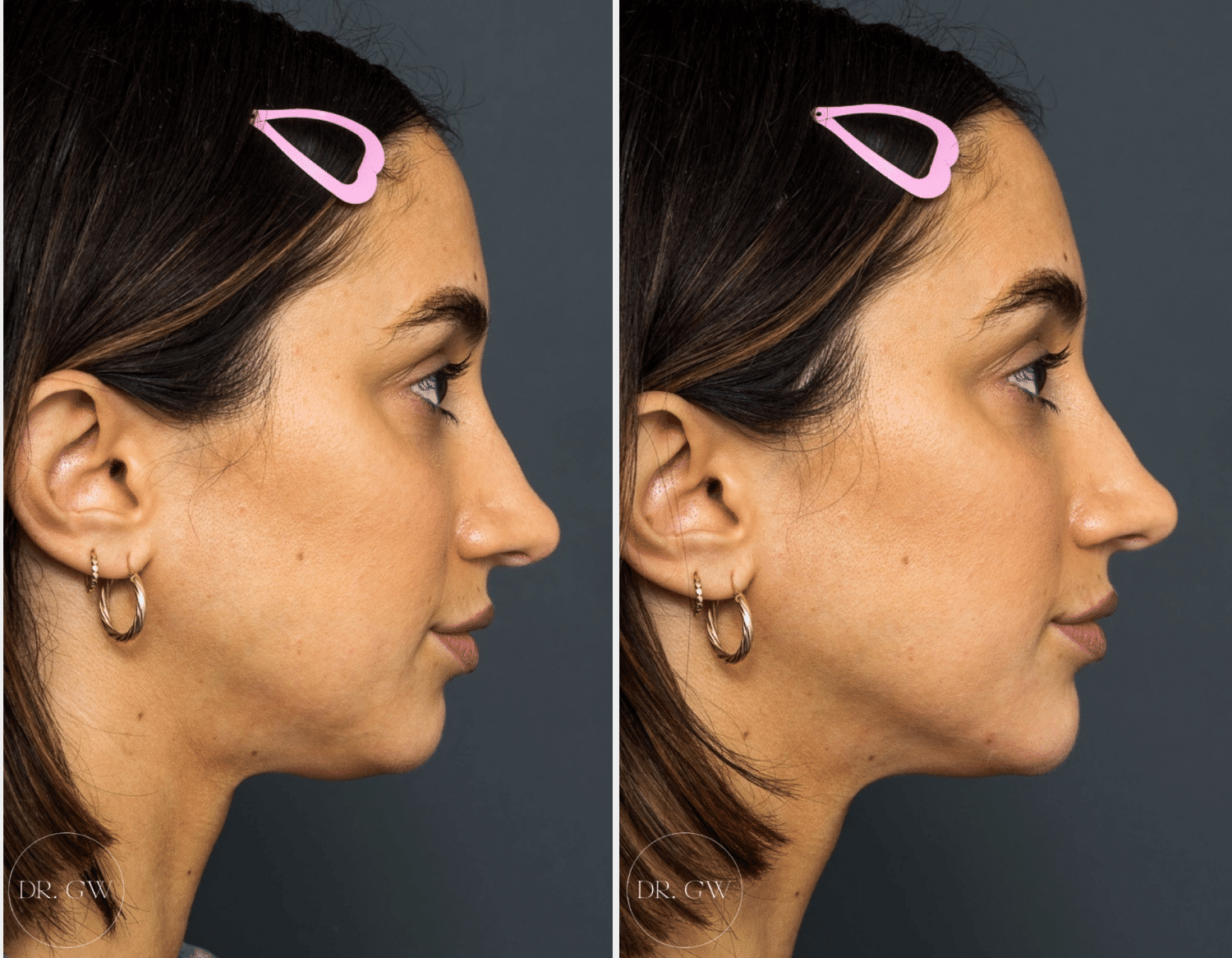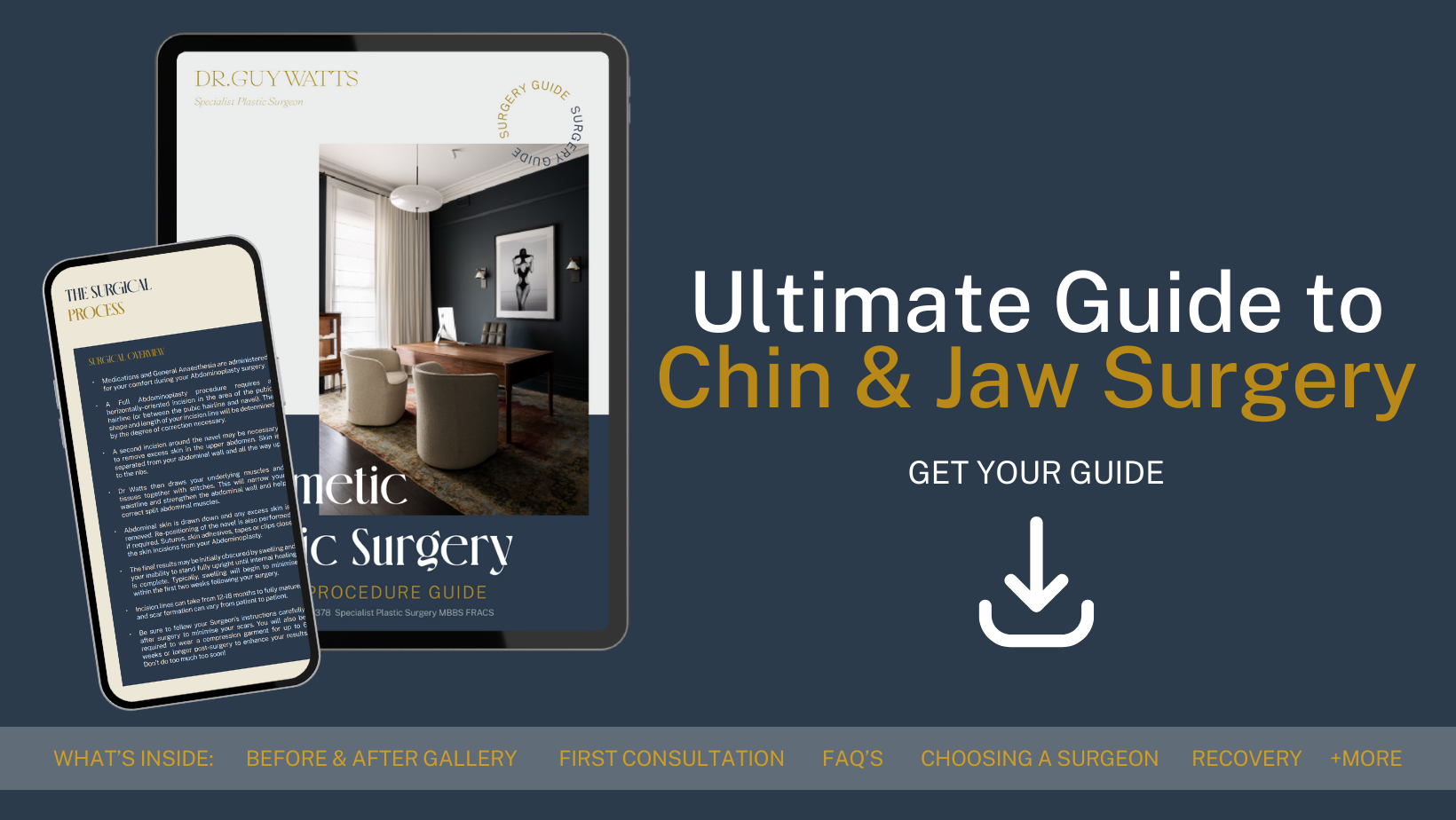
16 May Options for an Overly Prominent Chin
How to Alleviate a Prominent Chin
An overly prominent chin is a condition where the chin protrudes more than the rest of the facial features. This can lead to a disproportionate facial appearance. Nowadays, people may choose chin reduction surgery for a variety of reasons, including medical and aesthetic concerns. For some people, having a larger chin can cause functional issues, such as difficulty speaking or chewing. In these cases, genioplasty can increase the function of the jaw and reduce discomfort. On the other hand, many people seek chin reduction for aesthetic reasons. By reshaping or reducing the size of the chin, surgery can lead to a more proportionate facial profile.
Perth Specialist Plastic Surgeon Dr. Guy Watts has the necessary skills and experience to help you alleviate an overly prominent chin, with either surgical or non-surgical intervention.
Take our quiz, and find out if you are ready for surgery
What Causes an overly Large Chins?
An overly prominent chin can be caused by a variety of factors, including genetics, hormonal imbalances, and developmental abnormalities.
- Genetics: The size and shape of the chin are largely determined by genetics, so individuals with a family history of large chins may be more likely to have one themselves.
- Hormonal imbalances: Hormonal imbalances, such as an excess of testosterone, can lead to the development of a more prominent chin. This is because testosterone promotes bone growth, which can result in a larger chin.
- Developmental abnormalities: In some cases, developmental abnormalities can lead to the development of a large chin. For example, people with a condition called acromegaly may experience excessive bone growth throughout the body, including the chin.
- Other factors: Other factors, such as poor posture or habitual teeth grinding, can also contribute to the development of a large chin. In rare cases, a large chin may be a symptom of an underlying medical condition, such as a tumour.
It is important to note that while a large chin may be aesthetically undesirable to some, it is not necessarily a medical concern unless it is causing functional problems, such as difficulty speaking or chewing. If a large chin is causing discomfort or other issues, you may choose to undergo chin reduction surgery to alter the appearance of the chin and face.
DOWNLOAD DR WATTS’ GUIDE TO JAW & CHIN SURGERY

Surgical Options for an Overly Prominent Chin
If you don’t like the size or shape of your chin, you should know that there are surgical options available to help you achieve a more balanced and proportionate facial appearance. These options involve the reshaping or removal of a portion of the chin bone to alter the chins appearance.
1. Chin reduction surgery
Chin reduction surgery, also known as mentoplasty, is a procedure that reshapes and reduces the size of the chin by removing bone and/or soft tissue. The surgery is performed under general anaesthesia, and involves making an incision inside the mouth or under the chin. Dr Watts will then remodel the chin to alter the facial appearance. The procedure takes one to two hours, and recovery time may take several weeks. Potential risks of chin reduction surgery include infection, bleeding, nerve damage, and scarring.
2. Genioplasty
Genioplasty is a procedure that reshapes the chin by moving the chin bone either forward or backward. This can help balance the proportions of the face and lead to a more harmonious facial appearance. The surgery is performed under general anaesthesia, and involves making an incision inside the mouth or under the chin to access the chin bone. The surgeon will then reposition the bone to achieve the required shape and size.
Recovery time for genioplasty can take up to two weeks, and potential risks include infection, bleeding, nerve damage, and temporary numbness or weakness in the chin.
3. Orthognathic Surgery
Orthognathic surgery is a more complex surgical procedure that involves repositioning the entire jaw and realigning the teeth to alleviate structural issues in addition to altering the appearance of the chin. This procedure is recommended for individuals with significant jaw misalignment, bite problems, or other skeletal issues that contribute to their prominent chin. The surgery is also performed with the patient under general anaesthesia. During the intervention, the surgeon will make incisions inside the mouth to access the jawbone. Recovery time for orthognathic surgery can take several months, and potential risks include infection, bleeding, nerve damage, and temporary difficulty speaking or eating.
What Surgical Procedure is Right for Me?
Genioplasty, chin reduction surgery and orthognathic surgery are all procedures aimed at altering the appearance and structure of the chin and jaw, but they each serve different purposes and address different issues.
Chin Reduction surgery
Chin reduction surgery is a procedure that primarily focuses on reducing the size of the chin by removing bone or soft tissue, making it a good option for those with a chin that they perceive as too large or prominent.
Genioplasty
Genioplasty, on the other hand, reshapes the chin by moving the chin bone forward or backward, making it an ideal choice for individuals with either a receding or protruding chin. The procedure can alter facial proportions without drastically altering the size of the chin.
Orthognathic Surgery
Orthognathic surgery is a more comprehensive surgical intervention that alleviates issues with the jaw and teeth alignment in addition to the chin. This procedure is often recommended for patients with significant jaw misalignment, bite problems, or other structural issues, and it typically involves a more complex and prolonged recovery period.
It’s important to note that while all three procedures aim to alter facial symmetry and aesthetics, they each have unique requirements and considerations, and the choice of procedure will largely depend on the individual patient’s needs and desired outcomes.
Non-Surgical Options for an Overly Prominent Chin
While surgical options provide long lasting and effective results, patients may also consider non-surgical options to alleviate an overly prominent chin. Among these we can mention:
Jawline Contouring with Cosmetic Aesthetics to Alter Chin Proportions
Jawline contouring with Volumising treatments does not use incisions to alter the appearance of an overly prominent chin. The procedure involves the use of product inside a syringe that is then placed under the skin of the jawline to alter the balance and proportion of the facial appearance. The substance adds volume and definition to the jawline, which can help reduce the appearance of a prominent chin.
The procedure
The procedure is performed in a doctor’s office or clinic and can take less than an hour to complete. The plastic surgeon or nurse injector will start by assessing the patient’s facial structure and discussing their desired outcome. They will then mark the site on the jawline and apply a topical numbing cream to reduce discomfort during the procedure.
The substance is then placed into the marked areas using a fine needle. After the process is complete, the patient may experience some mild swelling or bruising, which typically dissipates within a few days. The results of jawline contouring with volumising treatments can last up to two years, depending on the substance used.
It is important to note that while jawline contouring with volumising treatments can alter the appearance of an overly prominent chin, it may not be suitable for everyone. Patients with significant bone structure or structural abnormalities may find surgical options such as chin reduction surgery or genioplasty to be more suitable.
FAQs about Options for Prominent Chin
What are the most suitable options for an overly prominent chin?
- The most suitable option for an overly prominent chin depends on the individual’s unique facial anatomy and desired outcome.
- Chin reduction surgery, also known as genioplasty, is a surgical option that involves reshaping or removing a portion of the chin bone to alter the appearance of the chin making it more balanced and proportionate.
- Non-surgical options, such as volumising or anti-wrinkle treatments, may also be used to reduce the appearance of an overly prominent chin in some cases.
Is genioplasty a painful procedure?
- Genioplasty is performed with the patient under general anaesthesia, so you should not experience any pain during the procedure. However, patients may experience some discomfort or soreness in the days and weeks following the surgery, which can be managed with medication and proper aftercare.
Are there any risks or complications associated with genioplasty?
- As with any surgical procedure, there are potential risks and complications associated with genioplasty, including infection, bleeding, and nerve damage.
- It is important to discuss these risks with a qualified and experienced plastic surgeon, and to carefully follow all pre- and post-operative instructions to reduce the risk of complications and optimise results.
How do Volumising treatments alter chin proportions?
- Volumising Treatments can be used to alter the appearance of the chin, which can lead to a more balanced and proportionate facial profile.
- Volumisers placed into the soft tissue of the chin, add volume and contour to alter the shape and size of the chin.
- The results of these treatments are temporary, lasting for between several months to two years, and can be adjusted or repeated as needed to achieve the desired outcome.
Are there any risks or side effects associated with Aesthetic Cosmetics?
- Yes, there are some side effects of volumising treatments, these include; swelling, bruising, and redness at the treatment site.
- These side effects typically tend to be mild and resolve within a few days. More serious complications, such as infection or allergic reaction, are rare but can occur.
- Make sure you are aware of the potential risks before undergoing treatment.
Further Reading about Face Procedures with Dr. Guy Watts
- Read Dr. Watts’ Jaw Surgery Page
- Read Dr. Watts’ Chin Augmentation Surgery Page
- Read Dr. Watts’ Blog about Top 5 Ways to Alter Your Nose
- Read Dr. Watts’ Non-Surgical Facial Options Page
- Read Dr. Watts’ Blog about What Makes Attractive Lips?
- Read Dr. Watts’ Blog about 10 Questions Patients Have about Recovery after Chin Surgery (Genioplasty)
Medical References about Prominent Chin
- Aesthetic Alteration of the Chin – NCBI
- Facial Implants & Chin Surgery – Cleveland Clinic
- Cheek, Jaw and Chin Implants – WebMD
About Dr. Guy Watts – MED0001539378
FRACS (Plas) – Specialist Plastic Surgeon In Perth WA
Dr. Guy Watts is a Specialist Plastic Surgeon (AHPRA MED0001539378) with an extensive career that spans across renowned plastic surgery clinics worldwide. His experience has been honed through invaluable experiences at esteemed establishments such as the New York Eye and Ear Infirmary and the renowned Pitanguy Clinic in Brazil.
Having collaborated with the foremost cosmetic plastic surgeons on a global scale, Dr. Watts has chosen to return to Perth after a 17-year journey of intensive training and invaluable professional experience to bring the latest practices and technology in cosmetic plastic surgery to his patients.
Dr. Watts is a Fellow of the Royal Australasian College of Surgeons (FRACS) and a Member of the Australian Society of Plastic Surgeons (ASPS), Australasian Society of Aesthetic Plastic Surgeons (ASAPS) and the International Society of Aesthetic Plastic Surgeons (ISAPS).
Read about the potential Risks and Complications of Surgery
Read the Patient Information and Resources
About CLINISPA
Clinispa is Dr Watts’ bespoke medical clinic performing Cosmetic Aesthetic treatments. At Clinispa, we offer advanced clinical treatments in a luxurious and calming environment, tailored to support your skin’s health and appearance.
Clinispa aesthetic services are performed by Dr Guy Watts’ nursing professionals, who have a passion for and solid understanding of facial aesthetics.
All Clinispa clients are considered individually, with a personalised treatment plan consisting of advanced scientific approaches to cosmetic aesthetics. We incorporate innovative technologies in conjunction with superiorly formulated skin care.
For more information about the full range of Clinispa Aesthetic of Cosmetic Treatments visit the Clinispa website








Sorry, the comment form is closed at this time.